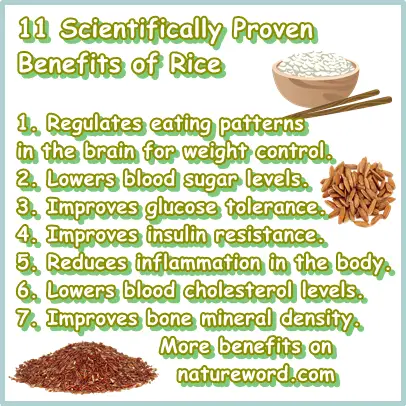Rice is a staple food almost everyone eats. Eating rice is good because it provides simple and complex carbs needed in the diet for macronutrient balance and elevated energy levels.
Colorful rice varieties are rich in antioxidants with proven anti-inflammatory benefits.
You can even eat rice in a diet for weight loss and a diabetic diet without side effects. But what does science have to say about the benefits of rice?
What are the benefits of rice according to science?
If you too incorporate rice in your diet all the time, then surely you will want to know what science has to say about the effects of eating rice on health. More specifically, the benefits of rice consumption of various aspects of health.
Read on to find out what are 11 scientifically proven benefits of rice.

1) Whole grain rice ameliorates bodyweight gain
Clinical observations propose that ‘daily intake of brown rice effectively ameliorates bodyweight gain’ (source). According to research, γ‐oryzanol, a compound obtained from brown rice bran attenuates the preference for consumption of fats which cause weight gain. The compound does so by essentially downregulating the activity of specific enzymes (deoxyribonucleic acid methyltransferases) in the brain reward system. This helps attenuate a dysregulated feeding behavior and ameliorate bodyweight gain, marking a source of benefits for weight management.
2) Colorful rice lowers blood sugar
According to research, eating colorful rice varieties such as black, purple and red rice can reduce blood sugar levels. The source of color is represented by pigmented antioxidants concentrated in the bran of the rice grains. Specifically, anthocyanins and proanthocyanidins.
Responsible for the natural color of red, purple and black rice, the pigmented antioxidants have been found to exert an inhibitory effect on α-amylase and α-glucosidase, enzymes required for the digestion of starch in humans. Studies showed extracts of all purple and red bran rice inhibited the activity of α-glucosidase, but only the red rice bran extracts inhibited α-amylase activity (source).
What this means is that the pigmented antioxidants in colorful rice varieties inhibit the conversion of starch to glucose in the small intestine, and delay the absorption of carbohydrates as sugar into the bloodstream (source), translating into blood sugar lowering effects.
Extracts of pigmented antioxidants from the bran of colorful rice varieties such as red and purple rice have also been shown in studies to increase the expression of specialized proteins GLUT1 and GLUT4 whose function is to transport the sugar glucose out of the bloodstream and into cells (source).

3) Whole grain rice improves glucose intolerance
Whole grain rice has a scientifically proven anti-diabetic action, with the more colorful rice varieties exhibiting a stronger antidiabetic activity. According to research, the primary bioactive components with antidiabetic action in whole grain rice are pigmented antioxidants such as anthocyanins and proanthocyanidins together with compounds such as γ‐oryzanol, complex carbohydrates and dietary fiber.
Glucose intolerance manifests as elevated levels of the sugar glucose in the bloodstream. Whole grain rice is a poor source of free sugars and simple carbs and, at the same time, high in complex carbohydrates and dietary fiber.
Its very nutritional profile contributes to limited glycemic effects which means that eating whole grain rice does not spike blood sugar to begin with.
Moreover, bioactive components in whole grain rice, especially in colorful varieties such as red, purple and black rice, help regulate feeding behavior in the brain, suppress the production of glucose as well as ‘activate insulin sensitivity’ and glucose uptake. What this does is help remove the sugar glucose from the blood and transport it to cells for use as fuel (source).
4) Colorful rice improves insulin resistance
Insulin resistance is when cells in the body are resistant to the effects of the hormone insulin produced by the pancreas.
When insulin resistance occurs, cells such as muscle, fat and liver cells don’t respond to the call made by insulin to remove the sugar glucose from the bloodstream, resulting in high blood sugar levels.
Biologically active components in whole grain rice such as pigmented anthocyanin and proanthocyanidin antioxidants from red, purple and black rice ‘activate insulin sensitivity’ (see source above) triggering the process of removing the sugar glucose from the bloodstream which lowers blood sugar levels.
Research has identified cyanidin-3-O-glucoside as one of the main bioactive components in colorful rice varieties such as black rice to improve insulin resistance, with benefits for diabetes prevention and management.
5) Whole grain rice improves levels of inflammation in the body
Oxidative stress is a source of inflammation in the body and is conducive to chronic disease. Consumption of foods that are high in antioxidants, such as colorful foods of the likes of black rice, black carrots, purple rice, purple sweet potatoes, purple and blue tomatoes, red rice, red sweet potatoes and others alike, helps combat oxidative stress and reduce levels of inflammation in the body.
A randomized, dietary intervention human clinical trial on the effects of acute consumption of colorful rice in humans showed that eating purple rice increases antioxidant activity in the body by 70.5% as well as reduces levels of MDA, a marker for oxidative stress, by 4% after 30 minutes. Consumption of red rice reduced levels of the inflammation marker by over 9%.
Purple rice also reduced levels of another inflammation marker, tumor necrosis factor alpha, by over 21% and over 25% after 1 hour and 4 hours respectively. Both purple and red rice reduced levels of Interleukin 6, a pro-inflammatory cytokine (source).
By comparison, brown rice consumption reduced levels of the inflammation marker C-reactive protein and its effects are primarily owed to its content of complex carbohydrates, notably indigestible dietary fibers with a scientifically proven anti-inflammatory action (source).
6) Whole grain rice has cholesterol lowering benefits
Rice bran, the colorful outer layer of the rice grain, is a source of cholesterol-lowering benefits. In a study on the effects of supplementation with rice bran enzymatic extract, it was shown that the extract increased good HDL (high density lipoprotein) cholesterol as well as increased the excretion of cholesterol, with anti-hyperlipidemic benefits.
In addition to lowering blood cholesterol levels, rice bran helps restore endothelial function (source), likely via anti-inflammatory and antioxidant pathways, which can be extrapolated into cardioprotective benefits. Similar effects have been observed from high-fiber diets which further recommends the consumption of whole grains such as whole rice for healthy blood cholesterol numbers and good cardiovascular health.
Red yeast rice has is also scientifically proven to exert cholesterol lowering benefits via a bioactive component that is chemically identical to the active ingredient in the statin medication known as Lovastatin.
7) Pigmented rice has a neuroprotective effect
One of the benefits of eating colorful rice varieties such as black, purple and red rice is a neuroprotective effect on nervous system cells. Studies have observed antioxidant constituents from rice bran such as ferulic acid and cyanidin 3-glucoside exert a neuroprotective effect on nerve cells, without toxicity. Red and black rice in particular are have the strongest neuroprotective action due to their high antioxidant content (source).
8) Whole rice is conducive to healthy weight loss
Diets of all kinds rely on one major principle for sustainability: balance. When it comes to weight loss diets, macronutrient balance is key to long-term success.
Losing weight and keeping it off can only be achieved successfully if there is no deprivation of essential nutrients. And carbohydrates are one such nutrient, essential in any diet.
Eating whole rice such as colorful black, red and purple rice, but also brown rice, represents an excellent source of complex carbohydrates which contribute to satiety and provide steady energy levels throughout the day. By not spiking blood sugar, complex carbs from whole rice combat cravings and overeating, supporting weight loss long-term.
9) Whole grain rice is a prebiotic food
Prebiotic foods are foods that are sources of components that nourish digestive microflora. Whole grain rice is one such food that stimulates the growth of beneficial gut microflora populations vis carbohydrates such as dietary fiber. While all whole grain rice varieties have modest prebiotic benefits, red yeast rice ranks first in terms of prebiotic activity.
10) Eating whole grain rice is good for bone density
Whole grain rice is a source of benefits for bone mineral density, providing nutrition that is conducive to achieving good bone mineral density.
Whole grain rice is high in manganese, phosphorus, magnesium and selenium, all minerals you need for bones and teeth health.
Not just this, but studies show antioxidants such as anthocyanins from brown, red, purple and especially black rice can help ameliorate diabetic osteoporosis (source). In an animal study, an anthocyanin-rich extract from black rice was demonstrated to lower blood sugar levels, increased bone mineral density and decrease serum bone turnover markers. Effects were dose-dependent, with high intakes of the extract returning bone microstructure to normal.
11) Whole grain rice is a functional food
Whole grain rice can be considered a food with functional properties (source 1, source 2), that is, a food with measurable beneficial effects for health. Some of the most notable health effects of whole grain rice, observable as a result of regular consumption, include:
- Regulation of intestinal transit for regular bowel movements and constipation relief.
- Contribution to macronutrient balance with healthy complex carbohydrates for elevated energy levels.
- Antidiabetic benefits: hypoglycemic action, benefits for glucose intolerance, insulin resistance and diabetes associated bone loss.
- Contributions to daily nutritional status: essential vitamins, dietary minerals, primarily complex carbohydrates, small amounts of protein, high amounts of antioxidants.
- Beneficial effect of endothelial health, with localized antioxidant and anti-inflammatory activities.
- Cholesterol-lowering properties with benefits for cardiovascular health as a whole.
- Anti-inflammatory and whole system benefits derived from the lack of gluten proteins.
- Scientifically proven anti-inflammatory effects derived from pigmented anthocyanin antioxidants in purple and black rice.
